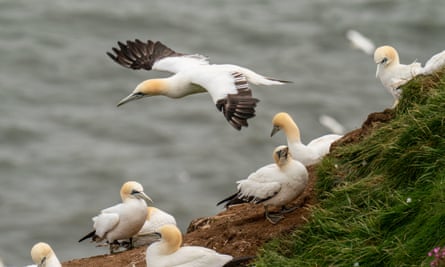Bird flu outbreaks rose nearly fivefold last year, creating an urgent need for research into preventing the spread of the disease, according to the head of a new consortium investigating the virus.
The record of 26 outbreaks involving H5N1 in 2021 has been shattered, with 121 outbreaks involving the H5 serotype this year, according to Prof Ian Brown, head of virology at the government’s Animal and Plant Health Agency (Apha).
This may be due to the growing number of people keeping chickens or ducks, Brown said. Many of these keepers do not have to register with any authority because of the small numbers of birds involved.
“A good percentage of our cases have been in those types of setting,” Brown said. “They’re in big commercial farms all the way down to somebody keeping two chickens in their back yard. So that is a massive shift in terms of the food security risk, public health risk, animal welfare and poultry exports.”
The Apha consortium was established by the Department for Environment, Food and Rural Affairs (Defra) at breakneck speed after last year’s outbreaks caused alarm and disruption among poultry farmers, and the first case of bird flu infecting a human in the UK.
“Over the past 10 years, we’ve had several bird flu events in the UK, but their frequency has been increasing,” Brown said. “Instead of coming every three or four years, we seem to be getting an event every year, and … they’re on a bigger scale.”
The risk to humans remains very low. Since bird flu emerged 20 years ago, about 600 cases have been recorded worldwide, with no human-to-human transmission.
But the Covid pandemic has underlined the risks posed by other potential zoonotic diseases – ones that are transmitted to people from animals. “The more humans are in contact with birds in an uncontrolled way, the greater is the theoretical risk that people can get infected,” Brown said, adding that the UK has “very good surveillance” of viruses. “If we can reduce the burden in birds, that also has a beneficial effect in reducing the risk to humans.”
Bird flu spreads to farmed birds from wild ones, and researchers are examining data collected over last winter to discover which practices make farms less vulnerable to infection. When the last winter’s wave began, the government ordered that all birds be kept indoors – known in agriculture as “housing” rather than lockdown – which meant that free-range eggs were unavailable in Britain for five weeks.

The virus moves between birds through close contact: “It’s droplet transmission – a bit like Covid,” Brown said. Faeces and nasal secretions – bird snot – are other vectors. Infectious droppings from wild birds as they fly over farms may be part of the problem. “Even at 4C, the virus will quite happily survive, infectious, for about eight weeks,” he added.
Another area of research is how and why wild birds fall sick: the illness is very distressing for the animals and often fatal. Thousands of birds have died in Scotland, most of them gannets nesting in close-knit colonies, as well as gulls and puffins.
“This is a concern because some of these are threatened species and defenceless against the virus. When these birds come to breed in summer, they get really close together. So it snowballs through these colonies.”
Wild bird migration is probably another factor, and some of the greatest mixing occurs in central Asian countries such as Kazakhstan, on an avian version of the Silk Road.
The virus usually disappears from Europe in summer but this did not happen last year. It also reached North America for only the second time. Few birds cross the Atlantic, so it’s likely that viruses were spread on by birds spending summer in the Arctic, which raises questions about whether the changing climate in the far north is also affecting the spread.
